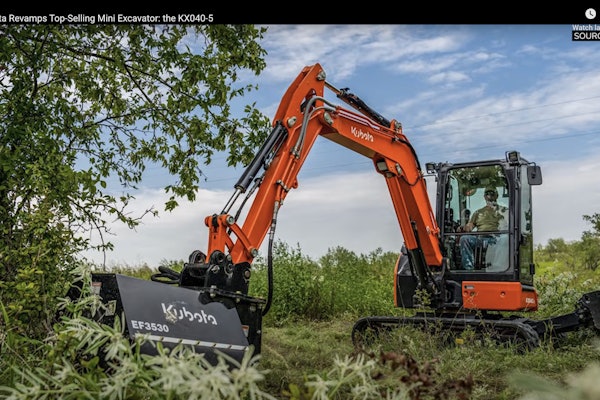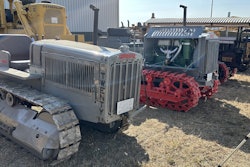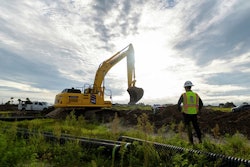Editor’s note: Spec Master delves deeper into the specifications reported in our annual Equipment World Spec Guide. This month’s guest experts: Mike Stec, sales engineer, and Nick Tullo, product specialist, Volvo Construction Equipment.
Payload rating (metric tons, short tons or pounds)
Payload rating is the amount of material that can be carried in the truck body. This is usually one of many values customers look at when making a purchasing decision.
Payload capacity (cubic meters, or yards)
Two terms are often used when describing payload capacities; struck or heaped. Contractors usually measure this capacity by cubic yards, and all manufacturers of articulated haulers specify payload capacity by loose cubic yards, not bank cubic yards. One way to explain struck volume is the example of filling up the truck body with water until it reaches the level of the sideboards and tail chute – no more water can be added since it would spill out. Trucks are designed to hold a theoretical load with a 2:1 heap in the body, although, of course, not all material heaps this way.
Empty machine weight (pounds)
Standards define empty machine weight as the mass of the machine with an empty bed, a 165-pound operator, a full fuel tank and all other fluid compartments at the manufacturer’s specified level. This includes, and may not be limited to, a full engine crankcase, cooling and hydraulic systems, transmission, differentials and final drives. Manufacturers must specify how the machine is equipped when this measurement is taken, including any optional equipment and/or special attachments.
Gross (loaded) machine weight (pounds)
The total operating weight of the machine is gained by adding the empty machine weight to the manufacturer’s payload rating. Certain standards also require manufacturers to list weight distributions between axles.
Loading height (feet, inches) (Point A on illustration)
This is the distance between the ground and the highest point of the sides of the articulated truck body, measured when the hauler is empty. Optional side boards will increase this height. If you typically load your hauler with a wheel loader, make sure the loader’s dump clearance (or hinge pin height) is sufficient enough to clear any side boards that may be on your truck.
Dump time, full cycle (seconds)
The time it takes to lift the truck body from the frame and return it again with the engine at the manufacturer’s rated speed.
Dump angle (degree)
This is the angle between the frame and the fully raised bed. This angle will help tell you how well you’ll be able to fully discharge the material from the bed.
Engine net horsepower
This is the horsepower provided from the engine when fully equipped, which typically includes accessories (air filter, muffler and cooling fan) necessary to perform its intended service. It does not include components that power auxiliary systems. This must not be confused with gross horsepower, where the test engine is equipped only with the air filter and muffler. The difference between net and gross will provide a good understanding of the power saved and how efficiently the machine’s systems work together.
Torque (foot-pound)
Torque is frequently thought of as a force that rotates or turns things – in essence, the application of horsepower. An easy illustration of this force is a human using a wrench or screwdriver; tightening the lug nuts on a car wheel is another example. The English unit of torque is foot-pound.
Torque assists the hauler in climbing grades, traversing challenging terrains and even basic acceleration. Generally, end-users prefer a higher torque value when comparing specs.
Transmission type (Automatic, Powershift)
The majority of articulated haulers manufactured for the North American market today use automatic transmissions. Most models have powershift capability, which allows the operator to maximize rimpull or retarder force within a selected gear for specific applications.
Number of gear speeds (forward/reverse)
Articulated haulers usually have six forward gears and one or two reverse gears. A high reverse speed could make a big difference in overall cycle times in applications that have a significant amount of reversing.
Maximum speed loaded (mph)
Articulated haulers usually have a maximum speed of around 35 mph. An artic’s top speed is an important spec since no operator wants to run a slow truck. Be aware, however, in many cases haulers have average speeds of less than 12 mph, since these machines are designed to negotiate terrains where other machines or trucks cannot travel.
Drive wheels (4×4, 6×6)
Four-wheel drive is used in good operating conditions, resulting in less tire and drive train wear and reduced fuel consumption. All manufacturers provide the capability of constant six-wheel drive and various differential systems to negotiate tough operating conditions and steep grades.
Retarders (exhaust, compression, hydraulic, transmission, Jake brake, oil-cooled disc brakes)
There are a variety of retarders on the market, including Volvo’s engine exhaust brakes and hydraulic transmission retarders. Some manufacturers offer either some form of engine braking, transmission retarder, oil-cooled wet disc brakes or just service brakes.
Service brakes
Present articulated truck models offer a variety of brake types, including dry disc brakes, wet disc brakes and oil-cooled wet disc brakes. Some models offer wet disc brakes on the front and mid axles. Others, such as Volvo, have brakes on three axles.
Fuel tank capacity (gallon)
Articulated haulers are designed to work an 8- to 10-hour day without the need to refill the fuel tank. End users today are more concerned with fuel consumption or fuel efficiency (tons per gallon).
Overall length; Width, excluding
mirrors; Height, body down; (all measured in feet, inches) (Points B & C on Illustration)
All of these dimensions have an important role in transporting the machine, particularly matching the machine with the type of trailer you will use to haul from jobsite to jobsite. These measurements also come into play if there are any jobsite constraints such as tight work areas. Contractors will want to see these numbers coupled with the empty weight of the machine.
Outside turning radius (feet, inches)
This is one-half of the diameter of the circle made by the centerline of the outermost tire as an articulated hauler maneuvers through its tightest turn. It’s another dimension that might come into play if there are jobsite space constrictions.











